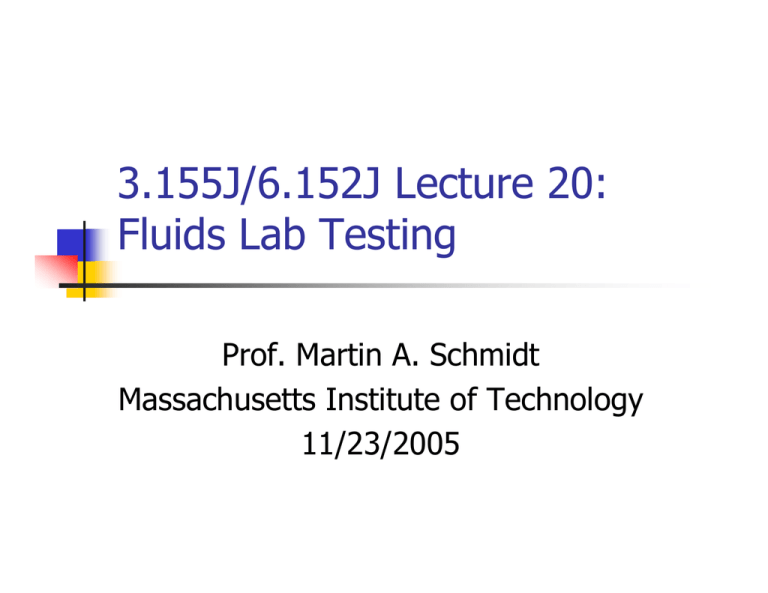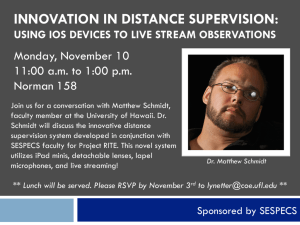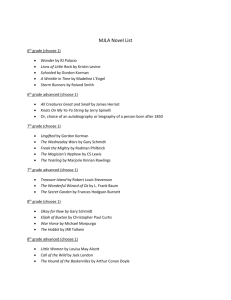Document 13509189
advertisement

3.155J/6.152J Lecture 20: Fluids Lab Testing Prof. Martin A. Schmidt Massachusetts Institute of Technology 11/23/2005 Outline Review of the Process and Testing Fluidics Solution of Navier-Stokes Equation Solution of Diffusion Problem Lab Report Guidance References Senturia, Microsystems Design, Kluwer 6.021 Web Site on Microfluidics Lab Plummer, Chapter 7, p.382-384 Fall 2005 – M.A. Schmidt 3.155J/6.152J – Lecture 20 – Slide 2 Process Flow - Overview Unexposed SU-8 (100 µm) Si Surface treatment & casting PDMS photolithography PDMS UV light Si mask removing elastomer from master Si PDMS development seal against glass after plasma treatment and insert tubing Si “master” tubing Fall 2005 – M.A. Schmidt Our process was changed here 3.155J/6.152J – Lecture 20 – Slide 3 The Mixer Width = 250µm, 500 µm Depth = 100 µm Inlet Length = 25 mm Outlet Length = 35 mm Courtesy of Dennis Freeman. Courtesy of Dennis Freeman. Images: Prof. D. Freeman Fall 2005 – M.A. Schmidt 3.155J/6.152J – Lecture 20 – Slide 4 Packaging/Testing Courtesy of Dennis Freeman. Courtesy of Dennis Freeman. Images: Prof. D. Freeman Fall 2005 – M.A. Schmidt 3.155J/6.152J – Lecture 20 – Slide 5 Experiment Gravity feed of fluids Particles for velocity measurement Requires ‘priming’ of channel We will attempt this Dye for diffusion experiments Measurements Particle velocity Diffusion Fall 2005 – M.A. Schmidt 3.155J/6.152J – Lecture 20 – Slide 6 Navier-Stokes The Navier-Stokes equation for incompressible flow: U = velocity P* = pressure (minus gravity body force) ρm = fluid density (103 kg/m3 for water) η = viscosity (10-3 Pa-s for water) Fall 2005 – M.A. Schmidt 3.155J/6.152J – Lecture 20 – Slide 7 Poiseuille Flow Assume width (w) >> height (h) Neglect entrance effects (L >> h) L w h y x Fall 2005 – M.A. Schmidt 3.155J/6.152J – Lecture 20 – Slide 8 Simplify to our problem No time dependence Flow is constant in xdirection (and 0 in z) d/dt = 0 U = f(y) Pressure is only a function of x A linear pressure drop Fall 2005 – M.A. Schmidt 3.155J/6.152J – Lecture 20 – Slide 9 Poiseuille Flow ILLUSTRATING POISEUILLE FLOW y h τw High P Low P τw Ux Umax Figure by MIT OCW. ‘No-Slip’ Boundary conditions Ux(y=0) = 0 Ux(y=h) = 0 Fall 2005 – M.A. Schmidt 3.155J/6.152J – Lecture 20 – Slide 10 Solution Solution is a quadratic polynomial Ux = a + by + cy2 Using boundary conditions and substitution Fall 2005 – M.A. Schmidt 3.155J/6.152J – Lecture 20 – Slide 11 Parabolic Flow Profile ILLUSTRATING POISEUILLE FLOW y h τw High P Low P τw Ux Umax Maximum velocity Flow rate Average velocity Fall 2005 – M.A. Schmidt Figure by MIT OCW. 3.155J/6.152J – Lecture 20 – Slide 12 Pressure drop over length ∆P = ρgH H = height of water g = gravity Courtesy of Dennis Freeman. Fall 2005 – M.A. Schmidt 3.155J/6.152J – Lecture 20 – Slide 13 Flow Issues Edge effects Flow rate Particle location in channel Dimensions Merging of channels How to model Courtesy of Dennis Freeman. Fall 2005 – M.A. Schmidt 3.155J/6.152J – Lecture 20 – Slide 14 The Mixer – Mixing by diffusion Width = 250µm, 500 µm Depth = 100 µm Inlet Length = 25 mm Outlet Length = 35 mm Courtesy of Dennis Freeman. Courtesy of Dennis Freeman. Images: Prof. D. Freeman Fall 2005 – M.A. Schmidt 3.155J/6.152J – Lecture 20 – Slide 15 Diffusion Image Sequence Think of this axis as length or time Fall 2005 – M.A. Schmidt 3.155J/6.152J – Lecture 20 – Slide 16 Imaging System Output Fall 2005 – M.A. Schmidt 3.155J/6.152J – Lecture 20 – Slide 17 Diffusion Same problem as diffusion in an epi layer As in the case of the design problem Dopant Concentration n - epi n+ - silicon Solution in Plummer, Chapter 7, p.382 Fall 2005 – M.A. Schmidt 3.155J/6.152J – Lecture 20 – Slide 18 Solution Initial Conditions C Initial Profile Identical to Infinite Source Problem: Diffused Profile x 0 Figure by MIT OCW. Reference: Plummer, J., M. Deal, and P. Griffin. Silicon VLSI Technology: Fundamentals, Practice, and Modeling. Upper Saddle River, NJ: Prentice Hall, 2000. ISBN: 0130850373. Fall 2005 – M.A. Schmidt 3.155J/6.152J – Lecture 20 – Slide 19 An ‘Intuitive’ way to look at it… Think of the uniform concentration as a Figure removed for copyright reasons. sum of dopant Refer to Plummer, J., M. Deal, and P. Griffin. Silicon VLSI Technology: ‘pulses’ Fundamentals, Practice, and Modeling. Upper Saddle River, NJ: Prentice Hall, 2000. ISBN: 0130850373. Each ‘pulse’ has a Gaussian diffusion profile Dose = C ∆x Apply superposition since diffusion is linear Fall 2005 – M.A. Schmidt 3.155J/6.152J – Lecture 20 – Slide 20 Solution Taking the limit of ∆x Fall 2005 – M.A. Schmidt 3.155J/6.152J – Lecture 20 – Slide 21 Solution Fall 2005 – M.A. Schmidt 3.155J/6.152J – Lecture 20 – Slide 22 Error Function Solution Figure removed for copyright reasons. Refer to Plummer, J., M. Deal, and P. Griffin. Silicon VLSI Technology: Fundamentals, Practice, and Modeling. Upper Saddle River, NJ: Prentice Hall, 2000. ISBN: 0130850373. Fall 2005 – M.A. Schmidt 3.155J/6.152J – Lecture 20 – Slide 23 Diffusion Issues Fitting ideal curve to measured profiles Scaling time to position Choice of velocity Non-ideal flow profiles Fall 2005 – M.A. Schmidt 3.155J/6.152J – Lecture 20 – Slide 24 Fluids Lab Report Follow the Letters format Report Flow Velocity Compare to calculated Estimate errors Extract an effective diffusion coefficient Purpose: Characterization of a Liquid Micromixer Utilize ‘best estimate’ for flow velocity Compare to expected (D ~ 2x10-6 cm2/s) Identify relevant non-idealities Fall 2005 – M.A. Schmidt 3.155J/6.152J – Lecture 20 – Slide 25





